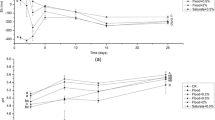Abstract
In a 2-year field study, the effects of four heating regimes established by varying temperature or duration of heating on efficiency of on-farm wastes as soil amendments in controlling Fusarium oxysporum f.sp. cumini (Foc) causing wilt on cumin (Cuminum cyminum L.), were ascertained. Significant improvement in reduction of Foc propagules was achieved with the increase in duration and amount of heat. In 2000, mild heating under shade (heat level 4), 31.8–65.9% reduction in Foc propagules was estimated in all the amendments at 0–30 cm soil depth, which improved by 75.7–86.5% in the treatment where Foc-infested soil brought from the laboratory was exposed to direct heat (heat level 3) and amendments and irrigation were applied. Foc propagules were reduced by 76.6–88.3% when infested soil was exposed continuously to dry heat for 56 days (heat level 2), improving efficiency of amendments by 0.9–13.5% compared with heat level 3. After 56 days of exposure to dry heat, elevating the temperature by mulching amended soil with a transparent polyethylene film (50 μm thick) for 20 days (heat level 1) augmented reduction by 80.2–95.5%. In the second season, combining 0.04% of onion, Verbisina encelioides or mustard oil-cake with mustard residues (0.18%) improved the reduction in Foc propagules at all heat levels even at the lower soil depth. Maximum reduction (94.9–100%) in Foc propagules at heat levels 1 to 3 was achieved when residues of Verbisina were supplemented with those of mustard. These results suggest a new approach to improve the control of Foc by combining prolonged heating with on-farm wastes such as Verbisina residues and one summer irrigation.

Similar content being viewed by others
References
Arora, D. K., Pandey, A. K., & Srivastava, A. K. (1996). Effect of heat stress on loss of C, germination and pathogenicity from chlamydospores of Fusarium oxysporum f. sp. ciceri. Soil Biology and Biochemistry, 28, 399–407.
Assaraf, M. P., Ginzburg, C., & Katan, J. (2002). Weakening and delayed mortality of Fusarium oxysporum by heat treatment; flow cytometery and growth studies. Phytopathology, 92, 956–963.
Baker, K. F., & Cook, R. J. (1974). Biological control of plant pathogens. San Francisco, CA, USA: W.H. Freeman.
Elad, Y., Katan, J., & Chet, I. (1980). Physical, biological and chemical control integrated for soil-borne diseases in potatoes. Phytopathology, 70, 418–422.
Freeman, S., & Katan, J. (1988). Weakening effect on propagules of Fusarium by sub-lethal heating. Phytopathology, 78, 1656–1661.
Gamliel, A., & Stapleton, J. J. (1993). Effect of soil amendment with chicken compost or ammonium phosphate and solarization on pathogen control, rhizosphere micro-organisms and lettuce growth. Plant Disease, 77, 886–891.
Israel, S., & Lodha, S. (2004). Factors influencing population dynamics of Fusarium oxysporum f.sp. cumini in the presence and absence of cumin crop in arid soils. Phytopathologia Mediterranea, 43, 3–13.
Israel, S., Mawar, R., & Lodha, S. (2005). Soil solarization, amendments and bio-control agents for the control of Macrophomina phaseolina and Fusarium oxysporum f. sp. cumini in aridisols. The Annals of Applied Biology, 146, 481–491.
Katan, J., Greenberger, A., Alon, H., & Grinstein, A. (1976). Solar heating by polyethylene mulching for the control of diseases caused by soil-borne pathogens. Phytopathology, 66, 683–688.
Lifshitz, R., Tabachnik, M., Katan, J., & Chet, I. (1983). The effects of sub-lethal heating on sclerotia of Sclerotium rolfsii. Canadian Journal of Microbiology, 29, 1607–1610.
Lodha, S. (1995). Soil solarization, summer irrigation and amendments for the control of Fusarium oxysporum f. sp. cumini and Macrophomina phaseolina in arid soils. Crop Protection, 14, 215–219.
Lodha, S., Gupta, G. K., & Singh, S. (1986). Crop disease situation and some new records in Indian arid zone. Annals of Arid Zone, 25, 311–320.
Lodha, S., & Mawar, R. (2007). Integrated disease management in seed spices. In: S. K. Malhotra & B. B. Vashishtha (Eds.), Production, development, quality and export of seed spices (pp. 119–138). Ajmer, India: National Research Centre on Seed Spices.
Lodha, S., Sharma, S. K., Mathur, B. K., & Aggarwal, R. K. (2003). Integrating sub-lethal heating with Brassica amendments and summer irrigation for control of Macrophomina phaseolina. Plant and Soil, 256, 423–430.
Mawar, R., & Lodha, S. (2002). Brassica amendments and summer irrigation for the control of Macrophomina phaseolina and Fusarium oxysporum f.sp. cumini in hot arid regions. Phytopathologia Mediterranea, 41, 45–54.
Mawar, R., & Lodha, S. (2006). Relative efficacy of on-farm weeds as soil-amendment for managing dry root rot of cluster bean in an arid environment. Phytopathologia Mediterranea, 45, 215–224.
Mawar, R., & Lodha, S. (2009). Prior weakening of Macrophomina phaseolina and Fusarium propagules for enhancing efficiency of Brassica amendments. Crop Protection, 28, 812–817.
Papavizas, G. C. (1967). Evaluation of various media and antimicrobial agents for isolation of Fusarium from soil. Phytopathology, 57, 848–852.
Sharma, S. K., Aggarwal, R. K., & Lodha, S. (1995). Population changes of Macrophomina phaseolina and Fusarium oxysporum f.sp. cumini in the oil cake and crop residue amended sandy soils. Applied Soil Ecology, 2, 281–284.
Snedecor, G. E., & Cochran, W. J. (1967). Statistical methods (pp. 258–298). Calcutta, India: Oxford & IBH Publishing Co.
Stapleton, J. J., & Duncan, R. A. (1998). Soil disinfestations with cruciferous amendments and sub lethal heating: effects on Meloidogyne incognita, Sclerotium rolfsii and Pythium ultimum. Plant Pathology, 47, 737–742.
Tjamos, E. C., & Fravel, D. R. (1995). Detrimental effects of sub-lethal heating and Talaromyces flavus on microsclerotia of Verticilliun dahliae. Phytopathology, 85, 388–392.
Author information
Authors and Affiliations
Corresponding author
Rights and permissions
About this article
Cite this article
Israel, S., Mawar, R. & Lodha, S. Combining sub-lethal heating and on-farm wastes: effects on Fusarium oxysporum f.sp. cumini causing wilt of cumin. Phytoparasitica 39, 73–82 (2011). https://doi.org/10.1007/s12600-010-0126-4
Received:
Accepted:
Published:
Issue Date:
DOI: https://doi.org/10.1007/s12600-010-0126-4




